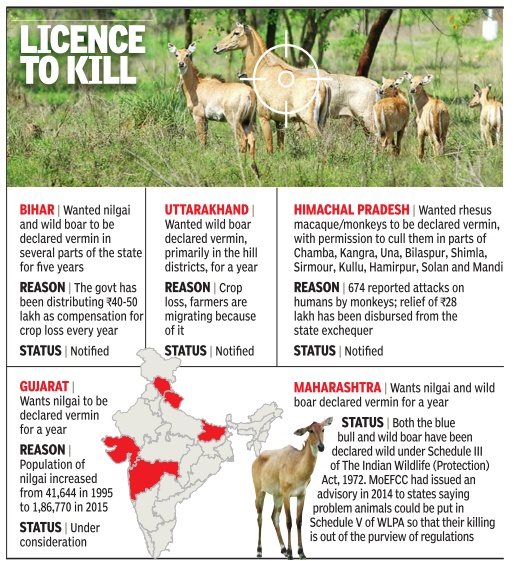Indian Wildlife (Protection) Act, 1972
This is a collection of articles archived for the excellence of their content. |
2016
SC: Culling of straying nilgais, wild boars allowed
The Times of India, Jun 21 2016
AmitAnand Choudhary Holding that wild animals cannot be hunted in their habitat, the Supreme Court on Monday refused to stay the Centre's notifications allowing culling of nilgai, wild boar and monkey with a caveat that the animals could be eliminated when they venture into human settlements. A bench of Justices Adarsh Kumar Goel and A M Khanwilkar, however, agreed to hear petitions filed by animal rights activists challenging the Centre's notifications allowing culling of nilgai and wild boar in Bihar, monkeys in Himachal Pradesh and wild boar in Uttarakhand and posted it for hearing on July 15.
It also directed the Centre to consider grievances of the activists within two weeks and asked them to make a representation before the government. The bench, however, ma de it clear that the process of culling must be done only when animals ventured out of their habitat. “You cannot hunt them in their home,“ it said.
Solicitor General Ranjit Kumar told the bench that it was clearly mentioned in the Centre's notifications that animals must not be killed in forest areas. He also raised the question as to why the activists challeng ed the notification several months after these were issued and pleaded them not to interfere in the ongoing culling of these animals in the three states.
The ministry of envi ronment and forest had on December 1 last year issued notification declaring nilgai and wild boar as vermin in Bihar and granted permission for their culling for one year. On February 2, it allowed culling of wild boar in Uttrakhand.
Once declared vermin, an animal is deprived of the protection under the Wildlife Protection Act.
Challenging the Constitutional validity of Section 62 of the Act, which empowers the Centre to declare a protected animal as vermin, petitioners contended that the provision is illegal as it conferred excessive and arbitrary powers on the government to permit “mindless“ slaughter of protected animals without holding any inquiry .
Declaring more animals as “vermin”
The Times of India, Jun 13 2016

Jayashree Nandi
Five states seek green ministry's nod to cull certain wild animals
Five states have responded so far to the environment ministry's advisory of 2014 which had sought proposals from all state governments regarding wild animals that could be declared “vermin“ under the Wildlife Protection Act. This would mean their killing will not be regulated anymore. While the Centre has already notified certain animals as “vermin“, the states' proposals, accessed by TOI through an RTI enquiry by activist Gauri Maulekhi, reveal that some haven't considered any scientific mananimal conflict management before deciding which animals should be culled.
However, experts have pointed out the reasons for seeking to cull these animals have not been argued properly . Uttarakhand, for instance, submitted that wild boars are affecting the livelihood of farmers in the hills and leading to their migration, but the proposal has no reference of their habitat management. “We haven't conducted any census of wild boars but the amount of crop damage is proof their numbers are going up,“ the proposal said.
Bihar, where the wild boar and nilgai have been notified as “vermin“ recently, claimed in their proposal that about 200 nilgais have been killed but the operation has hit a roadblock since its name has “religious“ connotations. Bihar forest department says there is always a “volley of questions in the state assembly in each and every session“ about conflict cases. “Forest officials find it very difficult to suggest a permanent remedy to people,“ the proposal said.
Both Gujarat and Himachal Pradesh have referred to studies conducted by their governments. Himachal has pointed out its 2015 survey of monkeys using fixed strip transect method. Gujarat in its proposal has claimed that nilgai numbers have increased from 41,644 to 1,86,770 in 2015, and with shrinking population of wild predators, their numbers are continuing to peak. Fixing solar, live wire and barbed wire fencing didn't help either.
However, the environment ministry's own advisory had observed that culling will not solve the nilgai problem, according to a study conducted by the Wildlife Institute of India .Scientists also fear the “short-cut“ method of culling will not address the real issue of man-animal conflict in the long run “These animals are part of the trophic structure.Their numbers have increased because of an acute lack of carnivores. The issue can be resolved only by scientific management of wild habitat. This will only lead to endangering the wild boar species ,“ said C R Babu, ecologist and DU professor emeritus. “Permissions for culling have been given to three states with no regard to the fact that none of the propos als show if a scientific survey of population or an assessment of carrying capacity of the habitat has been done. None of the proposals show if any measures for mitigation or adaptation have been carried out. They also do not reveal the impact assessment for rampant encroachment, fragmentation of forests and disappearance of corridors on these species,“ pointed Maulekhi.
Deepak Apte, director of Bombay Natural History Society, said, “Indians are a tolerant community and they have had close ties with the wild. Extermination may not be a good idea. Humane methods are available but expensive.“